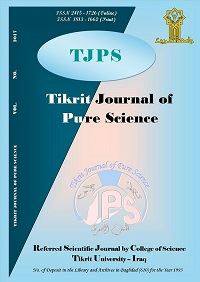Comparative study of Vitamin D levels in diabetic and non- diabetic women and its correlation with age and seasonal variation
DOI:
https://doi.org/10.25130/tjps.v24i2.347Abstract
Background vitamin D has characteristics features of a hormone, and accordingly vitamin D is a pro-hormone, rather than a true vitamin. Active form of vitamin D is binding to vitamin D receptors (VDR) then started its main action inside the body.
This study is aimed to compare concentration of vit. D in a patients with diabetes mellitus, and healthy Iraqi women and its correlation with seasonal variation, and age.
Subjects and methods This study was conducted in the first of August 2017 till the first of April 2018, at the outpatient unit in especial private hospital at karbalaa city in the south of Iraq. 163 women have been enrolled in present study. The sample was divided into 3 groups in both diabetic and non-diabetic subjects.
Results the distribution of subjects in this study, 163 persons participated as a sample in a present research; 82 subjects are normal healthy women as controls, while 51 women suffering from non-insulin dependent diabetic mellitus, (T2DM), and 30 pregnant women suffering from gestational DM, (GDM). Stander deviation and mean of Vit. D levels in a non-insulin dependent diabetes mellitus and normal healthy women. There is significant reduction in the levels of vit.D that measured by using sera of women patients suffering from T2DM, (12.97 ± 8.9) as compared with control subjects, (18.95 ± 7.1).
Conclusions the present study conclude that, the measurement of vit.D are significantly reduced when measured in women patients with non-insulin dependent diabetes sera, as compare to healthy subjects and also reduced in the sera of women patients suffering from GDM, as compared with control subjects.
Downloads
Published
How to Cite
License
Copyright (c) 2022 Tikrit Journal of Pure Science

This work is licensed under a Creative Commons Attribution 4.0 International License.
Tikrit Journal of Pure Science is licensed under the Creative Commons Attribution 4.0 International License, which allows users to copy, create extracts, abstracts, and new works from the article, alter and revise the article, and make commercial use of the article (including reuse and/or resale of the article by commercial entities), provided the user gives appropriate credit (with a link to the formal publication through the relevant DOI), provides a link to the license, indicates if changes were made, and the licensor is not represented as endorsing the use made of the work. The authors hold the copyright for their published work on the Tikrit J. Pure Sci. website, while Tikrit J. Pure Sci. is responsible for appreciate citation of their work, which is released under CC-BY-4.0, enabling the unrestricted use, distribution, and reproduction of an article in any medium, provided that the original work is properly cited.




